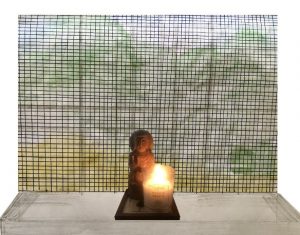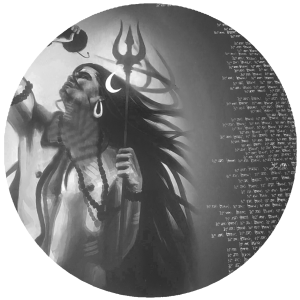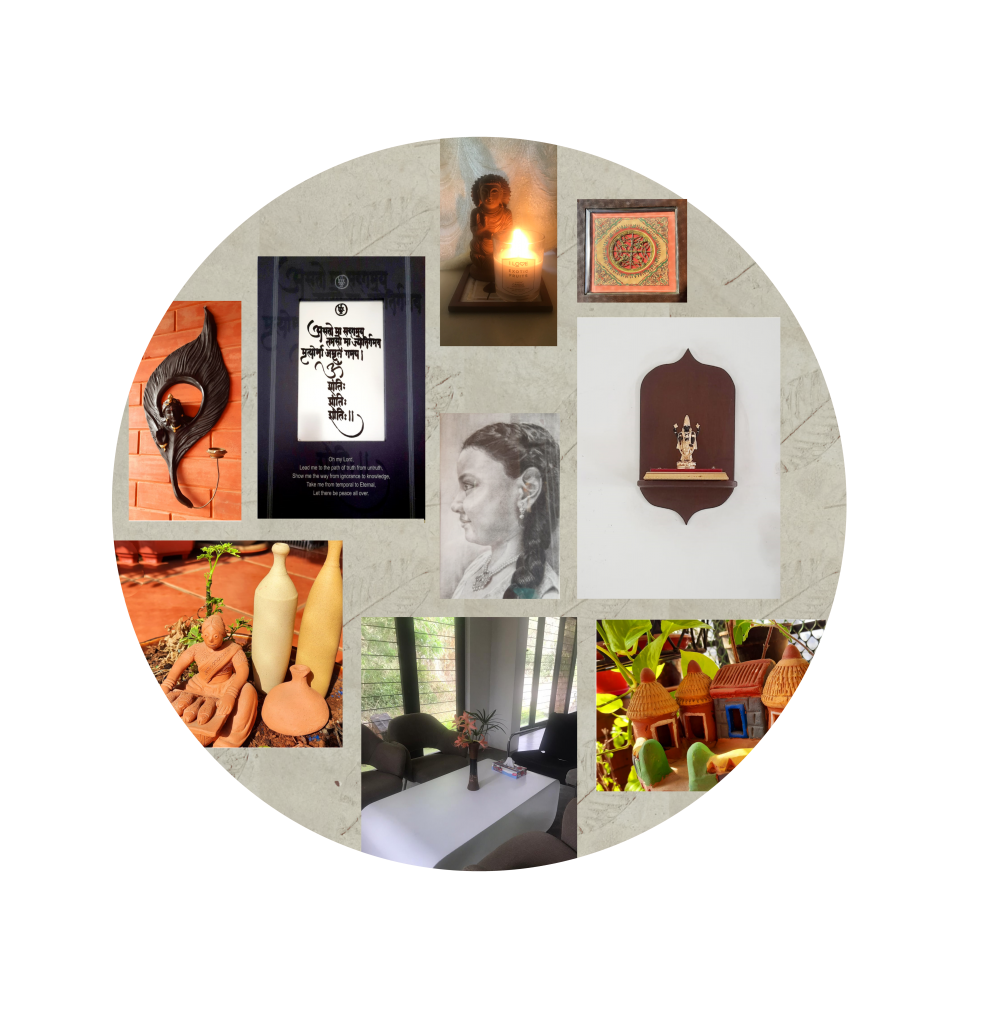“An Indian Sthapati has to be A YOGI, he must feel the vibrations in the cosmos including the materials and users of that place”- Ar. BV Doshi
As human beings we started decorating our space and expressing the self into our space right from the Stone Age when we started drawing our hunting experiences on the cave walls. An Architect observes, absorbs and listens to the whispers of the soil, trees, and balances the rhythm of the outer space and ‘chit akAsha’ that is the inner space. A designer’s roots go deep down in her parampara (culture), art and tradition similar to a strong rooted tree.
Modern lifestyles leave us little time to stop and consider the effect our surroundings have on us. We have reached a stage where the human race is capable of the most amazing feats on one side and the most amazing follies on the other. More and more people are turning to different approaches of living, in order to attempt or re-address the balance.
How can the sense of a dynamically changing natural system show us ways to bring alive the living space inside a house? How can we re-envision our living spaces?

- Consciously observing the space, the objects, their placements, their characteristics- shape, size, colours, form, material and texture.
- Sensitively becoming aware of all of them, reconfiguring the space so that it reflects inner-personality.
- Sensibly enhancing/ replacing one element at a time and observing the difference.
- Feeling the movement and changing energy of the space.
Every designer has a separate and personal impulse…so there are no set rules. One has to step into the world of intuition, inspiration, and talent.
One does right placement of the building on the site, balances built up areas and open spaces. She frames and emphasises views and as a response to the climate, a rational building emerges to give both function and form, happiness and meaning. She finds architectural answers to various needs and lifestyle systems.
She creates movement and makes one to experience and feel the space. These experiences could be a play of light, some open spaces giving visual rest in the enclosed volumes, a window overlooking a green space and the list goes on.
‘Architecture cannot be totally explained but must be experienced’ -Ar. Geoffrey Bawa.
vastu & vAstu
When a person selects her favourite space in the house and passionately designs it, be it a small corner of the room, a wall, a window, a terrace, a balcony, an open space around…that particular area gets an identity which reflects the inner self.
In the current contemporary Architecture/ designing context, there is a need to re-look at the idea of Interior design, Décor, as an impact of each object viz. vastu creating new energies in the space viz. vAstu.
There is a need to start a dialogue with clients for what ‘customisation’ could mean to them and what personal space means to them. Each house should have different expressions as it belongs to people who occupy it. This idea is directly proportional to the amount of time you would choose to spend into this space, into grooming the space and what the space will bring back to you.
Every material (vastu) has its own spirit and emotional identity. It should not be necessarily claimed ‘beautiful’, even a rough stone has its own beauty. There are plenty of commonly known and experienced examples which explains the statement- Natural materials such as cotton fabrics, hand woven rugs look fresh and inviting; Indoor plants, flower vases and green walls makes the space to breathe; Sculptures, purposeful images and symbols from the native culture add identity and support system to the space giving it a deep rooted essence.
Art of India has born out of a deep vision of life and when we focus on the inner self the art starts to speak and explain its importance to us. Interpretive skills and understanding which vAstu gives, with an age-old wisdom helps us to create nurturing and life enhancing supportive spaces. vAstu practitioners skillfully observe and connect with the energy/ies and establish such a connection for the inhabitants of the space.
A space gets potent only when it is inhabited, and the human inhabitation of space brings in changing vibrations and energies, hence the enhancement of the spaces also starts within ourselves. This is then reflected on the space which is a core aspect of vAstu- an inter-relation of the inhabitant and the space.
Just give it a thought…..
*Are you using your space sensitively/ consciously and is it helpful for your well- being?
*Do you believe in creating and un-creating spaces?
A well experimented and extensively research way forward to this journey would be becoming aware of
Panchendriyas- Five senses:
- Sight– What we see affects us directly- positive or negative sometimes also subconsciously so we may not even be aware of the effect. If we surround ourselves with wonderful views, cheerful colours, clean and clear environment, we are more likely to lead happy, healthy and a satisfactory life, because our surroundings will reflect a positive attitude to the spaces we inhabit.
Sight enhancers- Natural lights, lamps, natural décor like terracotta, relatable artwork, calm water.
- Sound- We all connect to a particular sound and even have our own favourite sounds. Gentle background music, rustle of leaves, bird chirping- all have a therapeutic effect.
Sound enhancers- Bells, wind chimes, water and sounds of nature.
- Touch- Touch is as vital as other senses and is linked to our primeval desire to be in contact with the earth. Different textures provide sensual appeal and give an object or space a character.
Touch enhancers- Plants, wooden objects, terracotta objects, fabrics, stone décor.
- Taste- It is difficult to describe in terms of vAstu but yet it forms as great a part of our well-being as any sense. “We are what we eat” – Ayurveda teaches us what type of food to eat according to seasons and prakruti (Nature).
Taste enhancers- Vegetable garden, a Tulasi (Indian Basil) Plant.
- Smell- Aroma from food, flowers, smell of the earth after the rain, smell of herbs and spices and incense enlighten our senses.
Smell enhancers- Flower and Fruit bearing trees and plants, vegetable garden, diffusers, fresh flowers.
When you explore and empower the space, the vAstu will say “TathAstu”!
Blog Contributors: Madhura and Shivangi


 Anoop is a student of Yoga, an entrepreneur, a coach and a father of two young boys. He has led successful leadership stints in both the corporate and non-for-profit sectors. On encountering the country’s water/farmer crises at close quarters, he decided to pause and examine the impact various ‘isms’ – capitalism, colonialism, etc., were having on us as individuals, families, the society and the environment at large. This quest led him to formally engage with traditional Indic knowledge systems while also learning from the latest advances in science – about our physical and mental wellbeing, importance of body and mind work in healing trauma and the urgent need for a conscious rebuilding of family / work / social structures if we have to thrive individually and collectively. Insights, frameworks and processes gleaned from these on-going studies, an anchorage in his own personal practice and his wide-ranging experiences is what Anoop brings to facilitation/coaching spaces in Ritambhara and his various professional engagements.
Anoop is a student of Yoga, an entrepreneur, a coach and a father of two young boys. He has led successful leadership stints in both the corporate and non-for-profit sectors. On encountering the country’s water/farmer crises at close quarters, he decided to pause and examine the impact various ‘isms’ – capitalism, colonialism, etc., were having on us as individuals, families, the society and the environment at large. This quest led him to formally engage with traditional Indic knowledge systems while also learning from the latest advances in science – about our physical and mental wellbeing, importance of body and mind work in healing trauma and the urgent need for a conscious rebuilding of family / work / social structures if we have to thrive individually and collectively. Insights, frameworks and processes gleaned from these on-going studies, an anchorage in his own personal practice and his wide-ranging experiences is what Anoop brings to facilitation/coaching spaces in Ritambhara and his various professional engagements.
 Priya is a Yoga therapist in the Krishnamacharya tradition. She adapts Reiki & energy work, Vedic chanting, life coaching & Ayurvedic practices in her healing spaces. She is committed to nurturing collectives that have the praxis of Yoga at their heart.
Priya is a Yoga therapist in the Krishnamacharya tradition. She adapts Reiki & energy work, Vedic chanting, life coaching & Ayurvedic practices in her healing spaces. She is committed to nurturing collectives that have the praxis of Yoga at their heart. Anisha has been on an exploration to understand herself through yoga for the last 15years which led her to teaching yoga, yoga therapy and inner work through yoga.
Anisha has been on an exploration to understand herself through yoga for the last 15years which led her to teaching yoga, yoga therapy and inner work through yoga. Apoorva chanced upon Yoga in her early 20s. A spark was lit within and there was no turning back. Her exploration led her to the Krishnamacharya tradition more than a decade ago. Curious about human behaviour and what drives it, she was thrilled when her search ended (and also began) when she first came upon the Yoga Sutra, which illuminated a path towards answering many questions that had been held for a long time.
Apoorva chanced upon Yoga in her early 20s. A spark was lit within and there was no turning back. Her exploration led her to the Krishnamacharya tradition more than a decade ago. Curious about human behaviour and what drives it, she was thrilled when her search ended (and also began) when she first came upon the Yoga Sutra, which illuminated a path towards answering many questions that had been held for a long time. Anita is a yoga teacher and therapist in the tradition of Sri.T.Krishnamacarya and Sri T.K.V. Desikachar, a Reiki practitioner and a Life Coach. She is also the founder of Vishoka, a center for learning Indic and energy-based frameworks for living and healing. Her deep concern for human suffering and the problems of unsustainable living kept her on the path of seeking an integrated approach to looking at life, living, learning and healing.
Anita is a yoga teacher and therapist in the tradition of Sri.T.Krishnamacarya and Sri T.K.V. Desikachar, a Reiki practitioner and a Life Coach. She is also the founder of Vishoka, a center for learning Indic and energy-based frameworks for living and healing. Her deep concern for human suffering and the problems of unsustainable living kept her on the path of seeking an integrated approach to looking at life, living, learning and healing. Ankit is a seeker in the wisdom traditions of India. The core of his work includes creating dialogic spaces where people can look within and see the connection between their inner and outer lives. Inspired by the likes of Gandhi, Aurobindo, Vivekananda and Guru Gobind his experiments in service took him back to his roots in Punjab where he is creating a community-led model of higher education which is open, inclusive and accessible for all. Ritambhara for him is a space for engaging in a community which is committed to a DHramic life. He anchors his work of learning and leadership in the Antaranga Yoga Sadhana and the humanistic wisdom of Mahabharata.
Ankit is a seeker in the wisdom traditions of India. The core of his work includes creating dialogic spaces where people can look within and see the connection between their inner and outer lives. Inspired by the likes of Gandhi, Aurobindo, Vivekananda and Guru Gobind his experiments in service took him back to his roots in Punjab where he is creating a community-led model of higher education which is open, inclusive and accessible for all. Ritambhara for him is a space for engaging in a community which is committed to a DHramic life. He anchors his work of learning and leadership in the Antaranga Yoga Sadhana and the humanistic wisdom of Mahabharata.
Great post.
Mam,good morning,wonderful article
Wow!